Conwy Castle | Visit Amazing Welsh Castles
Conwy Castle is one of the most complete and impressive medieval fortresses in Wales. Built between 1283 and 1287 by order of King Edward I, it played a crucial role in the English king’s campaign to conquer and control North Wales.
The castle forms part of Edward’s wider “iron ring” of defences, a network of strategically placed strongholds across Gwynedd.
Positioned above the River Conwy, the castle and its walled town were designed both to defend and to dominate. The massive curtain walls, eight towers, and well-preserved interior give visitors a rare glimpse into late 13th-century military architecture. It remains a symbol of Edwardian power and ambition in Wales.
Quick Facts
Date of Construction: Between 1283 and 1287
Location: Conwy, North Wales
Who Built It: Commissioned by King Edward I of England; designed by master mason James of St George
Key Purpose: Military fortress built to secure English rule over North Wales following Edward’s conquest of Gwynedd
A Brief History
The castle was built between 1283 and 1287 during King Edward I’s invasion of North Wales. It formed part of his larger campaign to control the region and was constructed alongside the fortified town of Conwy. Both were designed to assert dominance over the Welsh population.
The castle's architect, James of St George, was a Savoyard mason brought in by Edward. He used a design that made best use of the rocky coastal outcrop. With its high curtain walls and eight towers, the structure provided both strong defence and clear lines of sight across land and sea.
In 1294, during a Welsh uprising led by Madog ap Llywelyn, it was besieged. Edward himself was trapped inside for several months over the winter, supplied only by sea. The castle held firm, proving its strength.
During the 14th and 15th centuries, the castle saw periods of neglect and repair. It changed hands again in 1401 during the revolt of Owain Glyndŵr, when it was captured in a surprise raid.
By the 16th century, the castle had little military use and fell into disrepair. It was garrisoned briefly during the English Civil War but was slighted (partially dismantled) in 1665 to prevent future military use.
Today, although ruined, much of the structure remains intact, including interior rooms, spiral staircases, and the full circuit of the town walls.
Features and Layout
The castle has a compact, rectangular layout, shaped by the rocky ridge it stands on. It is divided into an outer ward and an inner ward, each defended by its own set of towers and walls.
There are eight massive towers in total. Four belong to the inner ward and four to the outer ward. All are circular and provide views across the town, river, and estuary. You can still climb several of them today.
The outer ward contained the barracks, storerooms, and other service buildings. A barbican protects the main gate on the town side. A second barbican faces the river, which allowed access to supplies by boat during a siege.
The inner ward is smaller but more secure. It housed the royal apartments, great hall, and chapel. The hall has lost its roof but remains clearly defined. Arched doorways and window openings still stand.
High curtain walls surround the castle and link all eight towers. The walls once supported wooden fighting platforms. You can still walk sections of the walls today, including the town walls, which stretch for over 1.2 kilometres.
There is no central keep, as the wall towers and inner ward provided sufficient defense and status.
Images
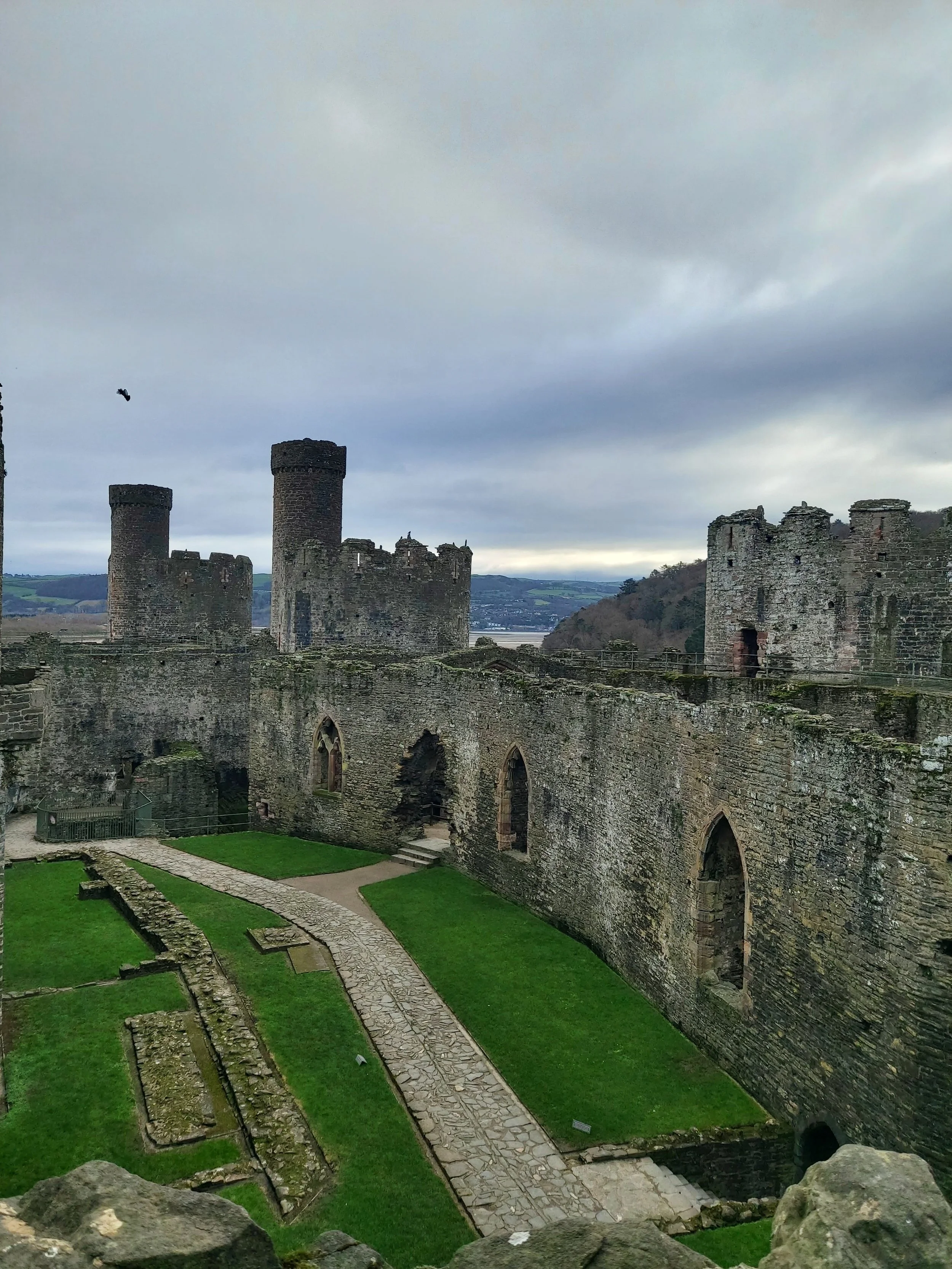

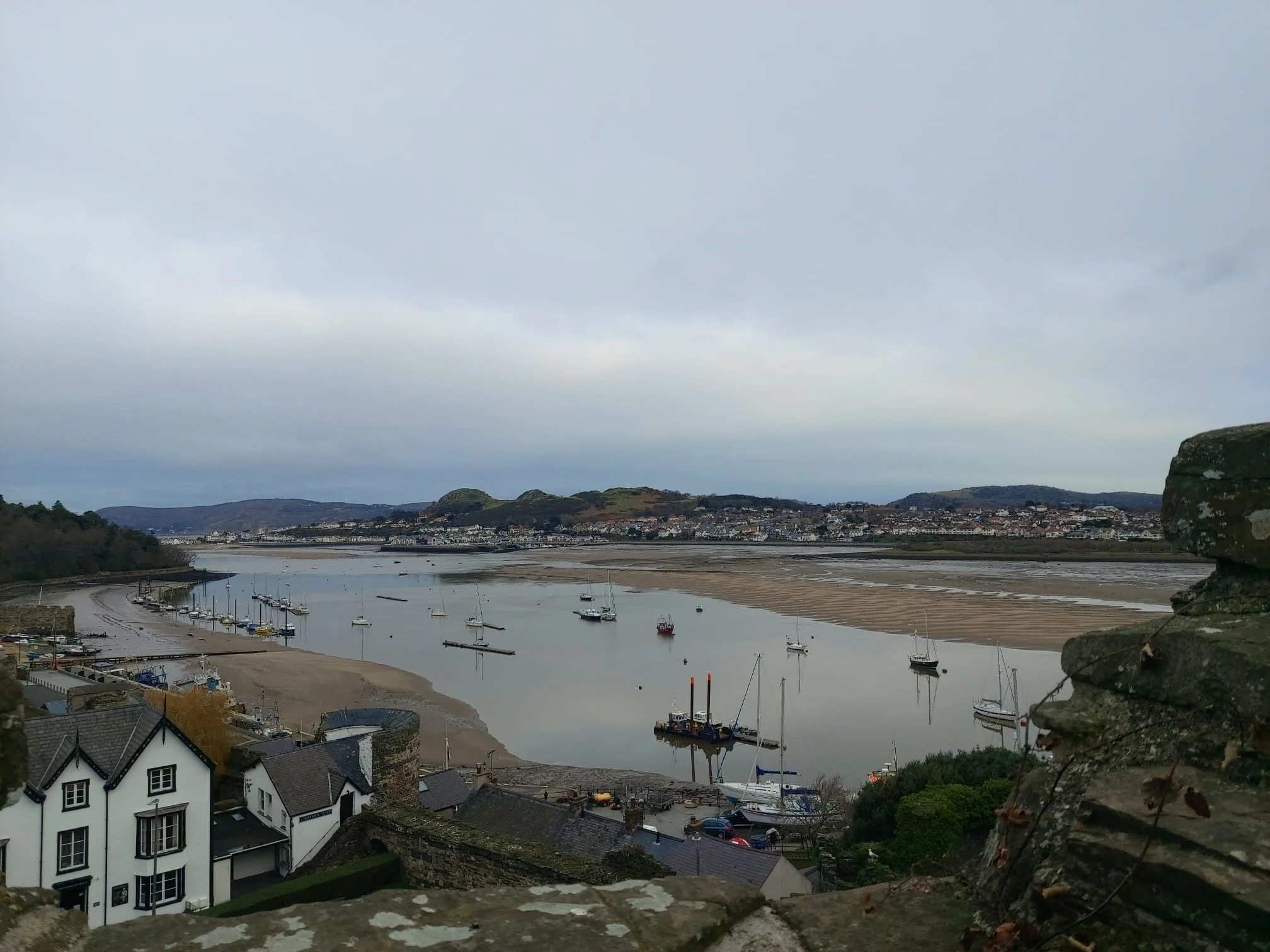

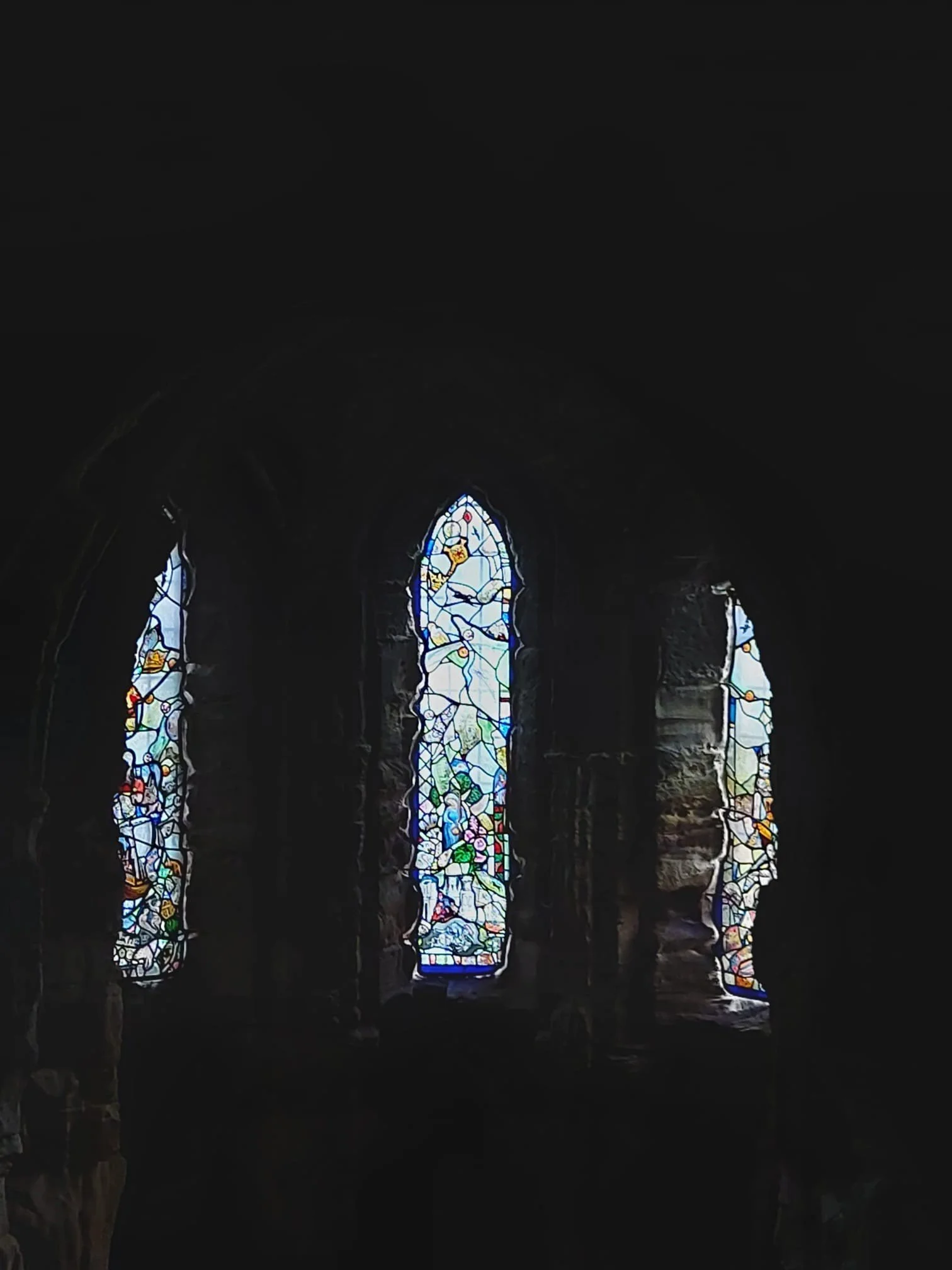

Legends and Stories
The castle has its share of local tales, though many are based in folklore rather than fact.
One of the most repeated legends involves the chapel. Some visitors and guides speak of ghostly monks still seen in the quiet corners of the castle, particularly near the former royal chapel. Cold spots and odd noises have been reported, especially in the early morning.
Another story comes from the 1401 capture of the castle by two of Owain Glyndŵr’s supporters. Rhys and Hywel ap Tudur reportedly climbed the walls disguised as carpenters. Once inside, they seized control from the small English garrison. The story is notable not for myth, but for the fact that the daring raid succeeded without major bloodshed, a rare event in the revolt.
There are also tales of a hidden treasure buried within the castle by fleeing soldiers during the Civil War. No treasure has ever been found.
Although none of these stories are confirmed by written records, they add to the sense of mystery around the ruins.
Visiting
Opening Times
1 March–30 June: 09:30–17:00 (last admissions 16:30)
1 July–31 August: 09:30–18:00 (last admissions 17:30)
1 September–31 October: 09:30–17:00 (last admissions 16:30)
1 November–29 February: 10:00–16:00 (last admissions 15:30)
Closed on 24, 25 & 26 December and 1 January
Ticket Prices
(Single-site ticket)
Adult: £13.10 (June–August); £12.50 (Sept–Mar)
Family (2 adults + up to 3 children): £42 (summer); £40 (winter)
Junior (5–17yrs) / Student: £9.10 (summer); £8.70 (winter)
Senior (65+): £11.70 (summer); £11.20 (winter)
Disabled person + companion: Free
Members: Free entry
Online booking offers a 5% discount and is available up to 24 hours before your visit
Directions & Transport
By road: Accessible via the A55 or B5106 to LL32 8AY.
By rail: Conwy station lies just 0.6 km (0.4 miles) away on the Crewe–Holyhead line.
By bus: Served by route No 5 (Llandudno–Conwy–Bangor/Caernarfon), 200 m from the site.
Cycling: Bike storage is available; the site links to National Cycle Network Route 5.
Facilities & Accessibility
Pay-and-display car park, with disabled spaces
Visitor centre with toilets and baby‑changing facilities
Accessible toilets; Wi‑Fi hotspot; water‑refill station
Portable hearing induction loop
On-site exhibition and gift shop
Site terrain is strenuous; expect uneven steps and slopes. Access guide is available.
Dog Policy
Only assistance dogs are allowed on-site.
Other dogs are not permitted inside the castle.
Nearby Attractions
There’s plenty to see around Conwy if you want to extend your visit.
Conwy Town Walls
These well-preserved walls stretch for over a kilometre and offer views across the town and estuary. You can walk large sections for free. They date from the same period as the castle.
Plas Mawr
Just a short walk from the castle, Plas Mawr is a fine example of an Elizabethan townhouse. Built in 1576, it showcases period architecture and interior design. Managed by Cadw.
Smallest House in Great Britain
Located on Conwy’s quayside, this tiny red house is only 72 inches wide. It was lived in until 1900 and is now open for visits.
Bodlondeb Woods
This peaceful woodland lies across the estuary, offering circular walks with sea and mountain views. It’s a good spot for quieter reflection or a dog walk.
Llandudno
Only 15 minutes away by car or bus, Llandudno offers a Victorian pier, promenade, and access to the Great Orme for coastal views and walking trails.
RSPB Conwy Nature Reserve
Located just south of the town, this wetland site is ideal for birdwatching. There are hides, walking paths, and family-friendly trails.
Visitor Tips
Wear sturdy footwear. The steps and wall walks are steep, narrow, and uneven in places.
Allow at least 1.5 hours to explore the full site, including towers and town walls.
Visit early or midweek if you want to avoid crowds. Summer afternoons can get busy.
Bring water, especially if climbing towers or walking the full circuit of walls.
Toilets are located at the visitor centre near the entrance.
Tickets are cheaper online if booked at least 24 hours in advance.
Pushchairs are difficult to use inside the castle due to the terrain. Use baby carriers if possible.
Parking is pay-and-display and can fill up quickly in peak season. Try to arrive before 11am.
The town is walkable. It’s worth exploring Conwy’s shops, cafés, and quay before or after your visit.
FAQs
-
Only assistance dogs are allowed inside the castle. Pets are not permitted.
-
Most visitors spend 1.5 to 2 hours exploring the castle and towers. Add more time if walking the town walls.
-
The site includes steep stairs and uneven ground. Some areas are not accessible for wheelchair users or those with limited mobility. Cadw provides an access guide online.
-
Yes. Entry is free, and you can walk large sections. The full circuit takes around 45 minutes.
-
Yes. A pay-and-display car park is available nearby. It includes disabled spaces but fills quickly in peak season.
-
You don’t have to, but online booking gives a small discount and speeds up entry.
Wrapping it Up
This castle offers one of the best-preserved examples of medieval military design in Britain. Its high towers, strong walls, and town defences reflect the strategic thinking of Edward I and his builders.
The site is compact but packed with interest. You can explore its towers, climb the walls, and walk through royal rooms built over 700 years ago. With its links to nearby attractions and good transport access, it’s a practical and rewarding place to visit.
Make sure you wear suitable footwear, check opening times, and consider booking online to save money. If you want to avoid crowds, aim for an early or midweek visit.
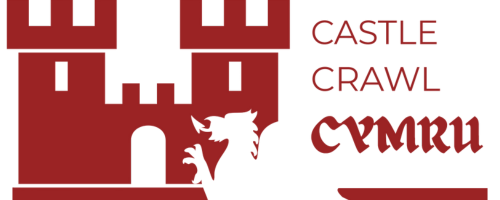

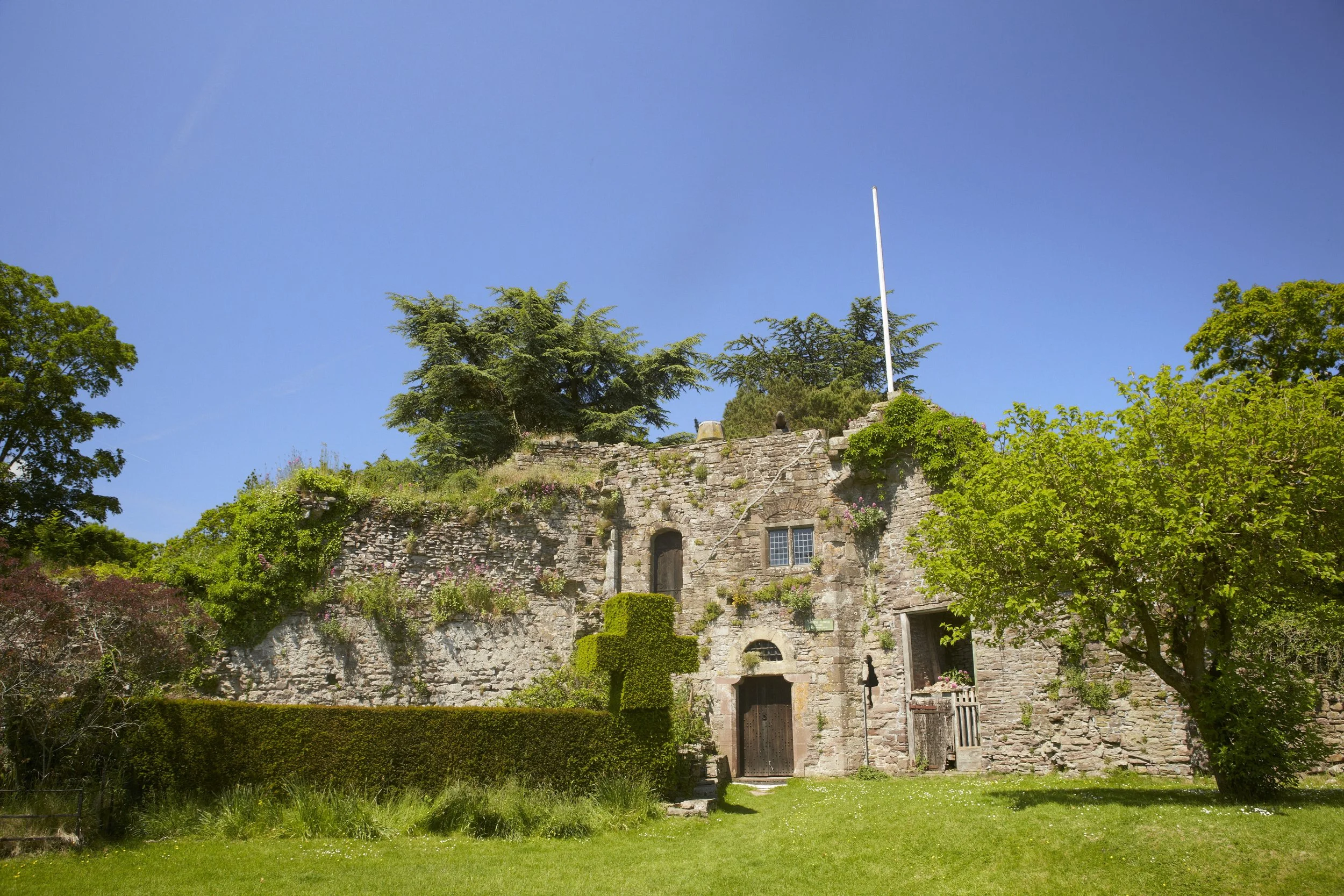

Cardiff Castle is a medieval and Victorian-era site in the centre of Cardiff, the capital of Wales.